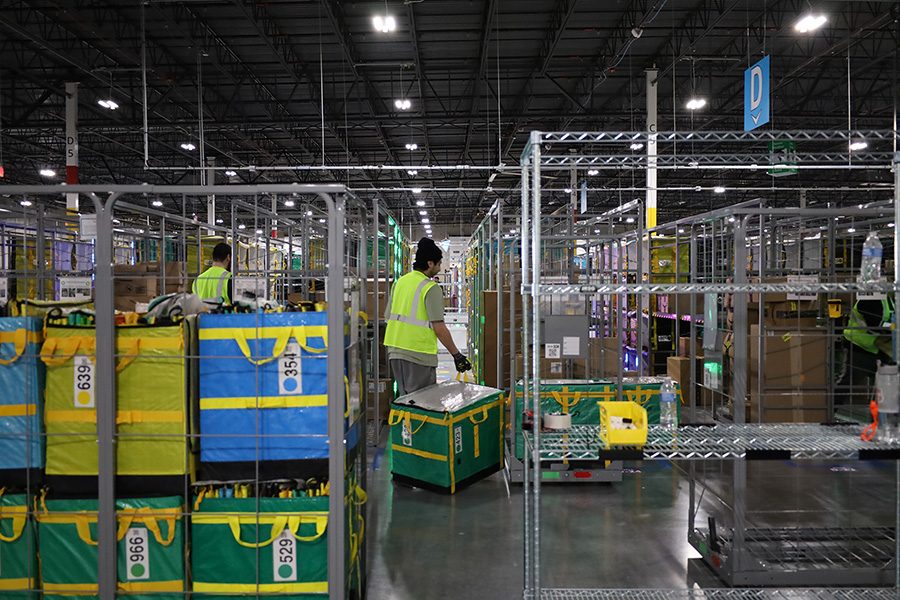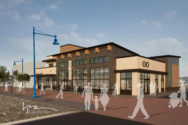
Home » Amazon’s new delivery station brings faster delivery times, jobs
Amazon’s new delivery station brings faster delivery times, jobs

The new Amazon delivery station in north Pasco handles 12,000 packages a day, but has capacity for up to 35,000 packages a day. It is fulfilling the Seattle-based company’s promise of faster deliveries and hundreds of new jobs, with more hires to come.
Photo by Nathan FinkeFebruary 13, 2025
The newly opened Amazon delivery station in Pasco is fulfilling its promise of faster service and hundreds of new jobs, with more hires to come.
The multimillion-dollar facility at 5802 N. Capitol Ave. in north Pasco quietly opened two months ago and has been ramping up its operations since. So far, it’s processed more than 1 million packages.
The warehouse is a last-mile facility, meaning that it’s the last stop in the Amazon delivery system before a package arrives at the customer’s doorstep – within two days or faster.
“Amazon follows the data,” said Erika Rocha, the facility’s site leader, who spoke during a Feb. 10 ribbon-cutting ceremony and tour.
“We follow where our customers are at. ... Our customers are here, and we need to service our customers and get that two-day promise.”
The delivery station is at the opposite end of Amazon’s complex delivery system from the national inbound cross dock at 1351 S. Road 40 E., which receives packages from vendors before a customer has even placed an order. That inbound warehouse, located near Sacajawea State Park, opened during the summer of 2024. Amazon officials said they don’t have any information to share about the plans for the empty warehouse built about the same time that’s directly across the street at 1202 S. Road 40 E.

Amazon’s Pasco delivery station serves 15 zip codes and will be expanding to serve 30 by April. Packages will be delivered to Moses Lake, Hermiston, Prosser, Grandview and Walla Walla.
| Photo by Nathan FinkeRamping up operations
The delivery station handles 12,000 packages a day, but has capacity for up to 35,000 packages a day. During peak seasons, like Prime month and the holiday season, that number could hit 45,000 packages in a single day, Rocha said.
Though situated on 25 acres in the Port of Pasco’s 93-acre Pasco Industrial Center 395, the facility won’t just serve the immediate vicinity.
Currently, the delivery station, which opened Dec. 12, sends packages to 15 zip codes, Rocha said, and will grow to serve 30 by April. Packages will be delivered to Moses Lake, Hermiston, Prosser, Grandview and Walla Walla.
While Amazon has a delivery station in Yakima, the two service areas won’t overlap. It’s about keeping the delivery within a feasible radius, Rocha said.
Before the Pasco facility opened, Amazon packages to the Tri-Cities bypassed delivery stations and were instead delivered by third parties, like FedEx and UPS.
The warehouse’s internal name, WWG1, represents its role. It is a part of Amazon’s RSR, which stands for “rural super rural” because it serves jurisdictions farther away from major hubs, like Hermiston and Pullman, Rocha said.
The original name for RSRs was “wagon wheel,” and when the name changed, the “W” stayed in the building’s shorthand. “WG” stands for Washington, and the 1 is because the facility would have been the first RSR to launch, but it didn’t turn out that way.
Currently, the Pasco delivery station is the largest RSR in Washington, Rocha said. There are currently 12 delivery stations in the state, said Scott Seroka, regional Amazon spokesperson.

A tour at Amazon’s Pasco delivery station watches as five lanes of vans line up and packages are efficiently loaded for delivery.
| Photo by Nathan FinkeHow it works
At 87,000 square feet, the two delivery stations is much smaller than the giant warehouses on Road 40 East.
Packages don’t stay there long. The goal is for them to spend less than six hours in the facility, Seroka said.
Between 2-6 a.m., boxes arrive from an Amazon sort center in Portland. They travel the length of the warehouse on a conveyor belt before employees move them to aisles of wire shelves.
In a process called “stowing,” employees scan packages and the corresponding shelf lights up with a bright color, indicating exactly where the package needs to go.
Before being loaded onto Amazon vans, packages are put into large, colorful totes and then onto carts. An Amazon app tells employees everything they need to know, from how many packages to take, to what route they’re on.
Drivers, in blue Amazon uniforms with matching hats and gloves, queue up in five lanes of white vans outside the warehouse. They load packages in the order of their stops for efficiency.
After 20 minutes of loading, the vans are off and the next wave of vehicles pulls up. A total of 70 vans are dispatched in one day.
“We want to make sure they get out on time, because when they’re on time, they’re on time to that first delivery,” Rocha said. “They get our customers happy.”
Hiring plans
To support the delivery effort, the warehouse employs a staff of 150 and is holding onboarding classes twice a week for the next three months. That’s twice as many onboarding classes as normal delivery stations offer, Rocha said.
And Amazon’s still hiring. The company hopes to bring on between 250 and 300 total employees, she said. The starting hourly wage is $20.25.
There are also 140 drivers who have been onboarded and 75 more going through training.
The company also is hiring flex drivers, who can help pick up delivery shifts as needed.
“There’s no shortage of the jobs here. We need people,” Rocha said.

A sign directs employees at the new delivery station at 5802 N. Capitol Ave. in north Pasco.
Celebrating the opening
Local officials were excited to welcome Amazon.
“Amazon’s really focused on not only investing in its people, but in our community,” said Pasco Mayor Pete Serrano after touring the facility.
The new facility features a logo with three coyotes, representing the three cities.
Colin Hastings, executive director of the Pasco Chamber of Commerce, said that Amazon has been a great partner. “For them to locate here in Pasco is extremely important for us, not only for the economic development, but for the jobs,” he said.
“I think when you have investments like this coming into our community, that’s going to drive more, because it puts us more and more on the map,” Hastings said.
Latest News Local News Education & Training Transportation
KEYWORDS February 2025
Related Articles
Related Products




